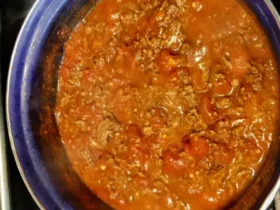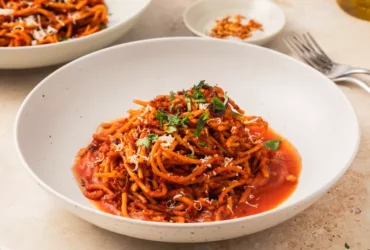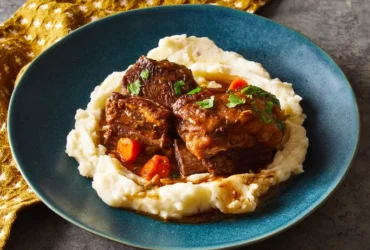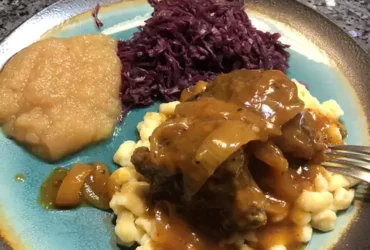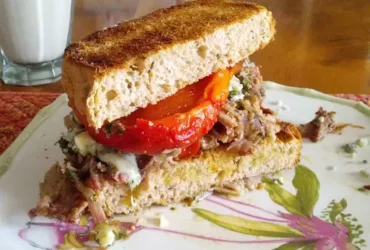Ingredients
Fresh Vegetables
The ingredients used for making delicious grilled vegetable kabobs are typically fresh vegetables with a focus on colorful and flavorful options.
This recipe can accommodate a wide range of vegetables, but some of the most popular ones include bell peppers, onions, mushrooms, cherry tomatoes, zucchini, yellow squash, eggplant, and red potatoes.
The use of fresh herbs such as parsley, basil, or rosemary adds an aromatic flavor to the dish.
Other ingredients that can be added for extra taste and texture are garlic, olive oil, salt, pepper, lemon juice, and sometimes even cheese like feta or parmesan.
Fresh vegetables such as bell peppers should be cut into large chunks, while onions and mushrooms need to be sliced, and cherry tomatoes should be halved.
For more complex shapes, like zucchini or yellow squash, they can be spiralized to make them easier to thread onto skewers.
Grilling vegetables brings out their natural sweetness and adds a smoky flavor, so don’t overcook them – instead aim for slightly tender but still firm texture.
This allows the vegetables to maintain their crunchiness while being fully cooked, resulting in an enjoyable combination of flavors and textures.
Colorful bell peppers (any color)
The star ingredient of our Grilled Vegetable Kabobs Recipe are colorful bell peppers, a versatile and nutritious addition to any meal.
These sweet and crunchy vegetables add natural sweetness, texture, and vibrant colors to our dish, making them an excellent choice for grilling.
Here are some key characteristics of the ingredients:
Type
Bell peppers come in a variety of shapes and sizes, but for this recipe, we recommend using bell peppers that are roughly the same size to ensure even cooking.
Color
While traditional green is the most commonly used color, we love incorporating other colors like red, yellow, orange, and purple to add visual interest and flavor variety.
Taste
Bell peppers have a slightly sweet and crunchy texture when raw, but when grilled, they develop a smoky sweetness that’s hard to resist.
Nutritional value
Bell peppers are rich in vitamins A and C, potassium, and fiber, making them an excellent choice for a healthy meal option.
When selecting bell peppers, look for ones that are firm, glossy, and have no visible signs of wrinkles or blemishes. You can use any color combination you like, but keep in mind that the cooking time may vary depending on the color:
- Green bell peppers: Will take about 8-10 minutes to grill.
- Red, yellow, and orange bell peppers: Will take about 10-12 minutes to grill.
For the best results, be sure to oil the bell peppers before grilling to prevent sticking and promote even browning. We love using a neutral-tasting oil like canola or grapeseed for this purpose.
Zucchinis
Zucchinis are a popular summer squash vegetable that can be found in most supermarkets and farmers’ markets during their peak season, typically from May to September.
The best zucchinis for grilling are those that are firm, heavy for their size, and have a dark green, glossy skin with no signs of soft spots or wrinkles.
Selecting the right variety can make a difference in the flavor and texture of your grilled zucchini. Some popular types include:
- Round or cylindrical varieties like ‘Black Beauty’ or ‘Straight Neck’, which are great for grilling due to their even shape and size
- Square or rectangular varieties like ‘Crookneck’ or ‘Pattypan’, which have a slightly sweeter flavor and can be grilled in slices or wedges
Before grilling, zucchinis should be washed and drained to remove any excess moisture. You can pat them dry with a clean towel or paper towels to remove excess water.
For grilling, zucchinis are often sliced into rounds or wedges about 1/2 inch (1 cm) thick. Slicing the zucchini too thinly can make it fall apart on the grill, so aim for thicker slices that will hold their shape.
You can also slice the zucchini in a specific pattern to enhance its visual appeal and flavor distribution. For example:
- Slicing into thick rounds, with each round slightly overlapping the previous one
- Creating alternating rows of sliced zucchinis and other vegetables, like cherry tomatoes or bell peppers
Zucchinis are a versatile vegetable that can be seasoned in many ways before grilling. Some popular options include:
- Olive oil, salt, and pepper for a simple yet flavorful approach
- Garlic powder or minced garlic for added depth of flavor
- Dried oregano or thyme for an Italian-inspired flavor profile
In addition to the basic grilling process, you can also try marinating your sliced zucchinis in a mixture of olive oil, lemon juice, and herbs before grilling. This will add extra moisture and flavor to your grilled vegetables.
Onions
The ingredients used to prepare a delicious grilled vegetable kabob recipe are quite versatile and can be found in most supermarkets or even grown in home gardens. For this particular recipe, we will focus on the ingredient onions.
Types of Onions
There are several types of onions that can be used in cooking, each with its unique flavor and texture. Some of the common types of onions include:
- Yellow Onions: These are one of the most commonly used onions in cooking and have a strong, sweet flavor.
- Red Onions: Red onions have a milder flavor than yellow onions and a sweeter taste.
- Shallots: Shallots have a mild onion flavor but are stronger than garlic. They’re often used in French cuisine.
- Scallions (Green Onions): These are young, green onions with a milder flavor and are often used as a garnish or in salads.
The choice of onion depends on personal preference and the type of dish being prepared. In this grilled vegetable kabob recipe, we will be using yellow onions for their strong flavor and texture.
Preparing Onions for Grilling
To prepare onions for grilling, they need to be sliced or chopped into bite-sized pieces. It’s essential to remove the papery skin from the onions before slicing them. To do this:
- Cut off both ends of the onion and peel the skin.
- Place the onion on its side and slice it into thick rounds or half-rings.
This will make it easier to thread the onions onto skewers and ensure even grilling. When grilling, brush the onions with a little oil and season with salt and pepper for added flavor.
Mushrooms
Mushrooms are an excellent addition to the Grilled Vegetable Kabobs Recipe, and they come in a variety of shapes, sizes, and flavors.
The most common types of mushrooms used in cooking include Button Mushrooms, Crimini Mushrooms, Portobello Mushrooms, Shiitake Mushrooms, Oyster Mushrooms, Enoki Mushrooms, and Morel Mushrooms.
When choosing mushrooms for the recipe, it’s essential to select fresh ones with a good texture and flavor. Look for mushrooms with firm caps and stems that are free of bruises or damage.
Mushrooms come in different colors, including white, brown, gray, black, and even colorful varieties like pink oyster mushrooms. Each type has its unique flavor profile, ranging from earthy to sweet and savory.
The size of the mushrooms also varies, with some types growing quite large, such as Portobello mushrooms, which can reach up to 6 inches in diameter. Smaller mushrooms like Button or Crimini are perfect for skewers and kabobs.
To prepare the mushrooms for grilling, simply clean them with a brush to remove any dirt or debris, then pat them dry with paper towels to prevent moisture from affecting their texture during cooking.
For the Grilled Vegetable Kabobs Recipe, you can use whole mushrooms, sliced mushrooms, or even mushroom caps. Simply thread them onto skewers along with other vegetables like bell peppers, zucchini, cherry tomatoes, and onions for a flavorful and colorful dish.
Mushrooms pair well with herbs like thyme, rosemary, garlic, and lemon juice, which are commonly used in the Grilled Vegetable Kabobs Recipe. You can also add a drizzle of olive oil or balsamic glaze to bring out their natural flavors.
Cherry tomatoes
Cherry tomatoes are a staple ingredient in many recipes, particularly those that feature grilled vegetables as the main attraction, such as our Grilled Vegetable Kabobs recipe. They add a burst of juicy sweetness and flavor to each bite, making them an essential component of this dish.
Cultivated from small tomato varieties, cherry tomatoes have a unique taste profile compared to their larger counterparts. Their smaller size allows for a sweeter flavor and tender texture that is unmatched by other types of tomatoes.
The sweetness of cherry tomatoes pairs perfectly with the smoky, slightly charred flavors imparted by grilling vegetables. When cut in half, they retain their shape and add visual appeal to the kabobs, providing an attractive contrast to the other ingredients.
Cherry tomatoes are also incredibly versatile and can be used in a variety of dishes beyond grilled vegetable kabobs. They’re perfect for adding fresh flavor to salads, pasta sauces, or as a topping for sandwiches and burgers.
To ensure optimal flavor and texture in our Grilled Vegetable Kabobs recipe, it’s essential to choose cherry tomatoes that are firm, but not hard or overripe. A slight give when pressed is ideal, indicating they’re ready for use in the recipe.
Flavor Enhancers
The Grilled Vegetable Kabobs Recipe requires a combination of fresh vegetables, flavorful oils, and seasonings to create a delicious and healthy dish. When it comes to choosing ingredients for this recipe, several key components come into play.
Vegetables
Select a variety of colorful vegetables that will not only provide a pop of color but also add different textures and flavors to the dish. Some good options include cherry tomatoes, mushrooms, bell peppers, onions, zucchini, and yellow squash. You can also add other vegetables such as eggplant, broccoli, or cauliflower for added flavor.
Oils
When it comes to cooking methods like grilling, using the right oil is crucial. Choose a high-quality oil that has a high smoke point, meaning it can handle high temperatures without breaking down or smoking. Some good options for grilling include avocado oil, grapeseed oil, and olive oil.
Flavor Enhancers
To add extra flavor to the vegetables, consider using natural flavor enhancers. Some popular options include herbs like thyme, rosemary, or oregano; spices like paprika, cumin, or coriander; and other ingredients like garlic powder, onion powder, or lemon zest.
Salt and Pepper
No matter what flavor enhancers you choose to use, it’s essential to season the vegetables with salt and pepper. Not only do these add flavor, but they also help to bring out the natural sweetness of the vegetables.
Olive oil
Olive oil is a primary ingredient used in cooking, including the Grilled Vegetable Kabobs Recipe.
It serves as the base for dressings and marinades, adding flavor to vegetables while also providing moisture to prevent drying out during grilling.
Main Characteristics of Olive Oil
- High smoke point: Olive oil has a high smoke point of around 420°F (220°C), making it ideal for high-heat cooking methods like grilling and pan-frying.
- Nutty flavor profile: Olive oil imparts a rich, nutty taste to vegetables, which complements their natural flavors and enhances the overall dish’s aroma.
- Antioxidant properties: Olive oil contains antioxidants like vitamin E and polyphenols, which help protect the body from damage caused by free radicals.
Benefits of Using Olive Oil in Grilled Vegetable Kabobs
- Enhances flavor: The distinct taste of olive oil complements the natural flavors of vegetables and adds depth to the dish.
- Moisturizes vegetables: Olive oil helps retain moisture in vegetables, preventing them from drying out during grilling.
- Promotes healthy eating: As a key component of the Mediterranean diet, olive oil encourages a balanced and nutritious eating approach.
Selecting the Right Type of Olive Oil
When choosing an olive oil for your Grilled Vegetable Kabobs Recipe, consider the following factors to select the best option:
Bottling process: Look for olive oils that are bottled in a dark glass container and have a tight-fitting lid to protect the oil from light exposure.
Labeling and certification: Check if the label indicates that the olive oil is certified by a reputable third-party organization, such as the International Olive Council or the California Olive Oil Council.
Country of origin: Consider the region where the olives were grown, as different countries may have distinct flavor profiles and quality standards.
Tips for Using Olive Oil in Grilled Vegetable Kabobs
- Use high-quality olive oil to avoid imparting unwanted flavors or odors.
- Mix olive oil with other ingredients, like lemon juice and herbs, to create a marinade that enhances the flavor of vegetables.
- Baste the grilled vegetables with additional olive oil during cooking to maintain their moisture and prevent drying out.
Garlic, minced
All ingredients play a vital role in bringing together the harmonious flavors and textures of Grilled Vegetable Kabobs Recipe, but none as aromatic and essential as garlic.
Garlic, minced, is typically used to add depth and complexity to the flavor profile of various dishes, including this recipe for Grilled Vegetable Kabobs. Its distinct pungency can enhance the natural sweetness of vegetables such as zucchini, bell peppers, onions, and mushrooms.
To begin incorporating garlic into your dish, you will first need to purchase some fresh cloves. These can be found in most supermarkets or grocery stores near other produce items.
The next step involves peeling the skin from the individual cloves using a chef’s knife or sharp paring tool. The best results often come from peeling just before mincing.
To properly chop the peeled garlic, place the clove on its side and locate the flat root end, which will serve as your reference point for even cuts. Hold your knife at an angle of about 45 degrees to it, then apply a gentle pressure and bring the blade down through the center of the clove.
Continue making parallel cuts along the length of the garlic clove until you reach the tip end where you can cut the piece in half. Be careful not to crush or mash your cloves during this process as mangled pieces will be difficult to mince properly.
Once all cloves are halved, use a fine grater or microplane for the most even and efficient method of mincing the garlic. However, if you do not have access to such tools, it’s also acceptable to simply chop them up very finely using your chef’s knife. Simply place the flat side down on your cutting board, then chop at an angle across the surface.
The resulting minced garlic can now be added to other ingredients within this Grilled Vegetable Kabobs Recipe. Its fragrance and potency will likely enhance both the flavor and aroma of all surrounding vegetables as they cook on skewers over medium-high heat for about 10 minutes or until tender.
Keep in mind, while a small amount may be enough to make an impact, too much can overpower the dish and become overwhelming. It’s essential to balance it with other seasonings you’re using within your recipe for an overall well-rounded taste experience.
As you continue preparing Grilled Vegetable Kabobs, remember that proper storage of remaining garlic is crucial if you plan on saving leftovers or even growing them yourself in the future. Keep any unused cloves refrigerated at 40 degrees Fahrenheit (4 degrees Celsius) to maintain optimal freshness and prevent decay from occurring prematurely.
Store your minced garlic within an airtight container such as a glass jar with a tightly sealed lid, making sure not to cross-contaminate other ingredients in the process. This will preserve its integrity for later use without allowing any external factors like moisture or light exposure from affecting it negatively.
Garlic can also be frozen if you have too much and wish to save some for another time when fresh produce is out of season. Simply peel, chop into small pieces, then place these in an airtight container or freezer bag before storing it at 0 degrees Fahrenheit (-18 degrees Celsius) until needed.
Now that we’ve gone over how to properly use minced garlic within Grilled Vegetable Kabobs Recipe, let’s take a look at some additional tips for preparation:
Tips for peeling garlic quickly and efficiently
- Pierce the skin with your chef’s knife.
- Hold under cold running water to loosen the papery layer.
Maintaining garlic quality over time
- Choose firm, compact bulbs.
- Avoid bruising or damaging the cloves while handling them.
Cooking garlic without burning it
- Add to hot dishes at the very end of cooking time for minimal loss of flavor and aroma.
- Use a lower heat when sautéing, especially if using raw or pre-minced garlic.
Potential health benefits associated with garlic consumption
- Aid in the prevention of heart disease by lowering cholesterol levels.
- Provide antimicrobial properties to help combat infection and illness.
Freshly squeezed lemon juice
When it comes to the ingredients in our Grilled Vegetable Kabobs Recipe, one essential component is freshly squeezed lemon juice. This vibrant and zesty ingredient plays a significant role in enhancing the flavors and aromas of the dish.
Lemon juice is a natural preservative that helps maintain the color and texture of the vegetables while adding a burst of citrus flavor to each bite. The acidity in lemon juice also helps to balance out the sweetness of the vegetables, creating a harmonious and refreshing taste experience.
In this recipe, we recommend using freshly squeezed lemon juice to ensure the best possible flavor. Bottled or concentrated lemon juice may contain added preservatives, sugars, or artificial flavor enhancers that can alter the taste and aroma of the dish. By squeezing fresh lemons, you’ll get an intense, citrusy flavor that will elevate the overall flavor profile of your Grilled Vegetable Kabobs.
To squeeze fresh lemon juice, simply cut a lemon in half and use a manual or electric juicer to extract the juice from the pulp and seeds. You can also use a fine-mesh strainer or cheesecloth to strain out any remaining pulp or seeds, leaving you with crystal-clear lemon juice.
The amount of freshly squeezed lemon juice called for in this recipe is about 2-3 tablespoons per serving. Feel free to adjust the quantity to your taste preferences, as some people may prefer a stronger citrus flavor while others may prefer a more subtle hint of lemon.
Salt and pepper
The two essential seasonings that bring out the flavors of the grilled vegetables are salt and pepper.
Salt
Salt is a fundamental seasoning in every kitchen, adding flavor to foods by enhancing their natural taste and texture.
There are different types of salt available, but for grilling vegetable kabobs, you can use either kosher salt or sea salt.
Types of Salt
- Kosher Salt: A coarse-grained salt that has a milder flavor and a larger crystal size than table salt. Kosher salt is ideal for grilling because it dissolves quickly and doesn’t leave any residue.
- Sea Salt: Harvested from seawater, sea salt has a coarser texture and a more complex flavor profile compared to kosher salt. Use sea salt if you want to add a subtle salty flavor to your kabobs.
Pepper
Peper is another essential seasoning that pairs well with the sweetness of grilled vegetables.
The most commonly used type of pepper for grilling is black pepper, but you can also use white pepper or mixed peppercorns for a more complex flavor.
Types of Pepper
Black Pepper
The most widely used and accessible type of pepper. Black pepper adds a sharp, pungent flavor to grilled vegetables.
White Pepper
Made from the inner seed of the peppercorn, white pepper has a milder flavor than black pepper and is often used in dishes where visual appearance is important.
Mixed Peppercorns
A blend of different types of peppercorns, including black, white, and green. Mixed peppercorns add a complex, aromatic flavor to grilled vegetables.
Incorporating salt and pepper into your Grilled Vegetable Kabobs Recipe will elevate the flavors of your dish and create a delicious, savory taste experience.
Optional: dried oregano or thyme
- The key to a delicious grilled vegetable kabob recipe lies in the selection and preparation of the ingredients.
- The main ingredients for this dish are a variety of colorful vegetables that will be alternated on the skewers to create a visually appealing presentation.
- Vegetables: This can include a mix of bell peppers (any color), zucchini, yellow squash, cherry tomatoes, onions, and mushrooms.
- The addition of fragrant herbs such as dried oregano or thyme can enhance the flavor of the dish without overpowering the natural sweetness of the vegetables.
- Oregano: This pungent herb has a slightly bitter and earthy taste that pairs well with grilled meats and vegetables. Use it sparingly, as it can be quite potent.
- Thyme: With its delicate, minty flavor and aroma, thyme is a popular choice for grilled vegetable dishes. It adds a subtle depth of flavor without overpowering the other ingredients.
- In addition to these herbs, you may also want to consider adding some aromatics such as garlic or lemon juice to give the dish an extra boost of flavor.
Instructions
Preparation and Grilling
To prepare the perfect grilled vegetable kabobs recipe, it’s essential to start with proper preparation and attention to detail. The first step involves gathering all the necessary ingredients and equipment.
The required ingredients for this recipe include a variety of colorful bell peppers (any color), cherry tomatoes, red onion, mushrooms, zucchini, yellow squash, fresh parsley, olive oil, salt, pepper, and your preferred seasonings. Additionally, you’ll need bamboo skewers or metal kabob sticks, which should be soaked in water for at least 30 minutes to prevent them from burning during grilling.
Begin by washing all the vegetables thoroughly under cold running water to remove any dirt or debris. Pat them dry with paper towels and set aside.
In a bowl, whisk together olive oil, salt, pepper, and your preferred seasonings (such as garlic powder, dried oregano, or paprika) until well combined. This mixture will serve as the marinade for the vegetables.
Thread one bell pepper, one cherry tomato, one mushroom cap, one zucchini slice, and one yellow squash slice onto each bamboo skewer, leaving a small space between each vegetable piece to allow for even grilling.
Place the kabobs in a large bowl or zip-top plastic bag, and brush them generously with the marinade mixture, making sure each piece of vegetables is coated. If using a bag, massage the bag to ensure all pieces are well-coated; otherwise, use your hands to coat evenly.
Cover the bowl or seal the bag, refrigerate for at least 30 minutes to allow the vegetables to absorb the flavors and tenderize slightly. Alternatively, you can marinate them overnight in the refrigerator for a more intense flavor.
Preheat your grill to medium-high heat (about 400°F). Thread the kabobs onto the preheated grill, leaving about 1/4 inch of space between each skewer for even grilling. Close the lid and cook for 8-12 minutes or until vegetables are tender and slightly charred, turning occasionally.
Once cooked to your liking, remove the kabobs from the grill and place them on a serving platter or individual plates. Garnish with fresh parsley and serve immediately.
This delicious grilled vegetable kabob recipe is perfect for outdoor gatherings, potlucks, or simply as a healthy and flavorful meal any day of the week. Enjoy!
Preheat grill to mediumhigh heat.
The first step in preparing this delectable Grilled Vegetable Kabobs Recipe is to preheat the grill to medium-high heat. This initial preparation sets the stage for a perfectly cooked dish.
When preheating the grill, it’s essential to ensure that the heat source is at its optimal temperature. Medium-high heat typically ranges between 375°F and 425°F (190°C to 220°C) on most grills.
This temperature range allows for even cooking of the vegetables while also imparting a nice char and smoky flavor. If your grill doesn’t have temperature controls, you can test the heat by holding your hand about five inches above the grates.
If you feel heat, but it’s not intense, then your grill is at medium-high heat. However, if it feels very hot or even too hot to hold your hand there for more than a second or two, then adjust the heat accordingly.
Remember that different types of grills may vary in their temperature range and heat distribution. Therefore, it’s crucial to familiarize yourself with your specific grill model to ensure optimal results.
Once you’ve confirmed that your grill is at the correct medium-high heat setting, proceed to prepare the vegetable kabobs for grilling.
Thread vegetables onto skewers in a colorful pattern.
To create a visually appealing and flavorful Grilled Vegetable Kabobs dish, it’s essential to thread vegetables onto skewers in a colorful pattern.
Here are some steps to follow:
- Select a variety of vegetables that will hold their shape well when grilled. Some options include cherry tomatoes, mushrooms, bell peppers, onions, zucchini, and yellow squash.
- Cut the selected vegetables into bite-sized pieces to ensure they cook evenly.
- Thread a vegetable onto the skewer, followed by a colorful vegetable, creating an alternating pattern.
- Continue threading the vegetables in this manner until your skewer is about 2/3 full. This will allow for easy turning while grilling and prevent overcrowding.
- Leave about 1-2 inches of space between each vegetable to promote even cooking.
Tips:
- Alternate between dark and light colors to create a visually appealing pattern.
- Mix high-moisture vegetables, like cherry tomatoes, with low-moisture vegetables, such as bell peppers, for added flavor.
- Avoid overcrowding the skewer, as this can lead to steaming rather than grilling the vegetables.
By following these steps and tips, you’ll be able to create beautifully presented Grilled Vegetable Kabobs that will impress your guests and satisfy their taste buds.
Brush with olive oil, then sprinkle garlic and lemon juice over the veggies.
To prepare a delicious Grilled Vegetable Kabobs Recipe, it’s essential to follow some simple instructions that bring out the best flavors and textures of the vegetables.
Here are the steps to achieve this tasty dish:
Preparation Time
Before you start grilling, make sure to prepare your ingredients by washing and cleaning the vegetables thoroughly. This includes bell peppers, onions, zucchini, cherry tomatoes, mushrooms, and any other vegetables of your choice.
Cut and Skewer
Cut the cleaned vegetables into bite-sized pieces and thread them onto skewers or metal kabob sticks. Leave a small space between each piece to allow for even grilling.
Now, let’s move on to the key step of bringing out the flavors:
Brush with Olive Oil
Brush both sides of the vegetable skewers with olive oil. This will help prevent the vegetables from sticking to the grill and also add a richness to their flavor.
Sprinkle Garlic and Lemon Juice
Sprinkle minced garlic over the brushed vegetables, then drizzle lemon juice on top. The acidity in the lemon juice will help balance out the flavors and create a refreshing taste.
Other tips and suggestions to enhance your Grilled Vegetable Kabobs Recipe:
Add herbs and spices
Sprinkle some dried or fresh herbs like thyme, rosemary, or oregano over the vegetables for added flavor. You can also use a pinch of salt, pepper, or any other spice you like.
Grill to perfection
Preheat your grill to medium-high heat and grill the vegetable skewers for about 8-10 minutes on each side, or until they’re tender and lightly charred. Keep an eye on them to prevent burning.
Once your Grilled Vegetable Kabobs are cooked, serve them hot with your favorite sides or as a main course on their own. You can also store leftovers in the refrigerator for up to 24 hours and reheat them when needed.
Season with salt, pepper, and herbs (if using).
The final step in preparing this delectable Grilled Vegetable Kabobs Recipe is to season the vegetables with a blend of salt, pepper, and herbs (if using). This seasoning process not only enhances the natural flavors of the vegetables but also adds an aromatic depth that complements their textures.
To season the vegetables effectively, start by sprinkling a pinch of fine-grained salt over each vegetable. Salt serves as more than just a flavor enhancer; it helps to bring out the natural sweetness in the vegetables and acts as a preservative, inhibiting bacterial growth.
Next, add a few grinds of freshly ground black pepper to the vegetables. Black pepper not only adds a pungency that balances the flavors but also provides a cooling effect that can help to reduce inflammation in some individuals.
If you are using fresh or dried herbs such as thyme, rosemary, or oregano, now is the time to add them to your vegetables. Fresh herbs add an intense aroma and flavor that pairs particularly well with the smokiness of grilled food, while dried herbs provide a more subtle yet still aromatic contribution.
Be sure not to over-season your vegetables; the key is to achieve a balance between flavors rather than overpowering any one ingredient. A light hand when seasoning will allow the natural sweetness and texture of each vegetable to shine through in its own right.
Once seasoned, place the vegetable kabobs onto the grill, arranging them so that they are not overcrowded. Grill over medium-high heat for 10-15 minutes per side or until the vegetables reach your desired level of tenderness and browning.
This seasoning step may seem simple but it plays a critical role in elevating the flavors of this Grilled Vegetable Kabobs Recipe. By taking the time to season your vegetables thoughtfully, you’ll be rewarded with a dish that’s full of flavor and aroma, perfect for enjoying on its own or as part of a larger meal.
Grill for 1012 minutes, turning occasionally.
The instructions provided seem to be a crucial part of the Grilled Vegetable Kabobs Recipe, which involves grilling various vegetables to perfection.
To ensure that your grilled vegetable kabobs turn out delicious and tender, it’s essential to follow these steps carefully:
Step-by-Step Instructions
Firstly, preheat your grill to medium-high heat. This will help to achieve the perfect char on your vegetables without overcooking them.
While your grill is heating up, prepare your vegetable kabobs by threading cherry tomatoes, mushrooms, bell peppers, onions, and zucchini onto skewers.
Once your grill is hot, place the vegetable kabobs on the grates, turning occasionally. The time frame of 1012 minutes might seem a bit unusual, but it’s likely that this was meant to convey a range of times rather than a specific number.
In reality, the ideal cooking time for grilled vegetable kabobs will depend on various factors such as the size and thickness of your vegetables, the heat level of your grill, and your personal preference for doneness.
Here’s a more detailed guide to help you determine when your grilled vegetable kabobs are cooked to perfection:
Cooking Times and Tips
- Cherry tomatoes and mushrooms usually take around 5-7 minutes to cook, or until they’re tender and lightly charred.
- Bell peppers and onions typically require a bit longer, around 10-12 minutes, to become soft and slightly caramelized.
- Zucchini and other vegetables with a higher water content might take up to 15 minutes or more to cook through, depending on their size and thickness.
Remember to always keep an eye on your grilled vegetable kabobs while they’re cooking and adjust the cooking time as needed to avoid overcooking them.
Tips and Variations
Additional Ideas
To add variety to your grilled vegetable kabobs recipe, consider incorporating a mix of colors, textures, and flavors. Here are some tips and ideas to get you started:
Vegetable selection: Choose vegetables that will hold their shape when grilled, such as cherry tomatoes, mushrooms, bell peppers, onions, zucchini, yellow squash, and red potatoes. You can also add other vegetables like corn on the cob, eggplant, or portobello mushrooms for added flavor and texture.
Marination: Marinate your vegetables in a mixture of olive oil, herbs, garlic, lemon juice, and spices before grilling for extra flavor. This step helps to tenderize the vegetables and adds depth to their natural flavors.
Mix and match marinades: Experiment with different marinade recipes, such as an Italian-style blend of olive oil, basil, oregano, garlic, and lemon juice, or a spicy kick from a mixture of olive oil, chili flakes, cumin, and smoked paprika. This allows you to customize your flavor profile to suit your taste.
Adding protein: Consider adding protein sources like chicken, beef, pork, lamb, tofu, or halloumi cheese to your vegetable kabobs for added flavor and texture. You can also use seafood like shrimp or scallops for a seafood-inspired twist.
Herb garden on a stick: Skewer fresh herbs like rosemary, thyme, oregano, basil, or mint directly onto the vegetables for an aromatic and flavorful addition to your kabobs.
Dipping sauce: Offer a variety of dipping sauces, such as tzatziki, tahini, hummus, yogurt dill, or chutney, to complement the flavors of your grilled vegetable kabobs. This adds an extra layer of flavor and fun for your guests to enjoy.
Add protein like chicken or shrimp to make it a complete meal.
To take this delicious Grilled Vegetable Kabobs Recipe to the next level, consider adding protein sources like chicken or shrimp to make it a complete meal.
This variation not only boosts the nutritional value but also adds flavor and texture to each skewer. Simply thread chunks of boneless, skinless chicken breast or succulent shrimp onto the kabob along with your favorite vegetables.
Some popular protein additions include:
- Chicken breast, marinated in a mixture of olive oil, lemon juice, and herbs like thyme or rosemary.
- Shrimp, tossed with olive oil, minced garlic, and a pinch of paprika for added smokiness.
Other protein options to explore include:
- Beef strips, marinated in soy sauce and sesame oil for an Asian-inspired flavor.
- Tofu, pan-seared with a drizzle of honey and soy sauce for a sweet and savory twist.
- The key is to balance the flavors and textures so that each bite is a perfect harmony of protein, vegetables, and seasonings. Experiment with different combinations to find your favorite!
- Don’t forget to brush the kabobs with olive oil, season with salt and pepper, and grill over medium-high heat for 8-10 minutes, turning occasionally, until the vegetables are tender and lightly charred.
- This variation is perfect for a quick weeknight dinner or as a show-stopping main course for your next outdoor gathering. The possibilities are endless!
Mix in some heat with red pepper flakes or sliced jalapeños.
To add an extra kick to your grilled vegetable kabobs, you can mix in some heat with red pepper flakes or sliced jalapeños.
Here are a few tips and variations to consider:
- Add red pepper flakes to the vegetables before grilling for a subtle heat.
- Mince one or two slices of jalapeño and mix it into the vegetables for an added kick.
- Use sliced jalapeños on the kabobs for a spicy pop of flavor with each bite.
You can also experiment with different types of hot peppers, such as:
- Sliced serrano peppers for a milder heat.
- Chopped habanero peppers for an intense heat.
Remember to handle the hot peppers with care and avoid touching your eyes or other sensitive areas after handling them.
You can also consider pairing the grilled vegetable kabobs with a spicy sauce, such as:
- A chipotle tahini sauce for a smoky heat.
- A harissa yogurt sauce for a creamy and spicy kick.
The key is to balance the heat with other flavors in the dish, so don’t be afraid to experiment and adjust to taste.
For a Mediterranean twist, add Kalamata olives and artichoke hearts.
To give your Grilled Vegetable Kabobs a Mediterranean twist, consider adding some key ingredients that are characteristic of this culinary region.
The first addition to consider is Kalamata olives. These small, dark purple olives have a rich, fruity flavor and a meaty texture that pairs perfectly with the smoky sweetness of grilled vegetables.
Another Mediterranean staple to include is artichoke hearts. Canned or marinated artichoke hearts can be easily added to your kabobs for an extra burst of flavor and texture.
You can also consider adding some fresh herbs such as oregano, thyme, or rosemary to give your kabobs a more aromatic flavor profile.
Another variation to try is to add some feta cheese crumbled on top of your kabobs for an extra salty kick.
If you want to make your kabobs even more substantial, consider adding some grilled chicken or shrimp skewers along with the vegetables.
Finally, don’t be afraid to experiment with different types of vegetables and marinades to create a unique flavor profile for your Grilled Vegetable Kabobs.
Experiment with different seasonings like ground cumin or smoked paprika.
To elevate your Grilled Vegetable Kabobs, experiment with various seasonings to add depth and aroma to your dish.
One option is to use ground cumin, a warm, earthy spice commonly found in Mexican and Indian cuisine. Add it towards the end of grilling time to avoid overpowering the delicate flavors of the vegetables.
Alternatively, you can try using smoked paprika, which brings a rich, smoky flavor reminiscent of grilled meats. This is particularly well-suited for heartier vegetables like bell peppers or zucchini.
Another approach is to combine different spices and herbs, such as basil, oregano, and thyme. These Mediterranean staples complement a wide range of vegetables and add an authentic touch to your kabobs.
For those who prefer a more subtle flavor, try using lemon zest or balsamic vinegar glaze. The citrusy brightness of lemon zest cuts through the richness of the vegetables, while balsamic glaze adds a sweet and tangy note.
Remember to adjust your seasoning according to personal taste and the specific ingredients used in your kabobs. Feel free to experiment with other spices and seasonings to find the perfect combination that suits your palate!
- Best Datanyze Alternatives for 2025 - April 24, 2025
- Best Hunter.io Alternatives for 2025 - April 22, 2025
- Best Lead411 Alternatives for 2025 - April 22, 2025


